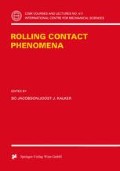Abstract
Rheometers able to measure non-Newtonian properties must induce the same stress and the same shear rate in the whole volume of the test liquid. Otherwise some kind of mean value of the shear stress-shear strain rate relationship will be measured by the instrument. The stresses induced in the liquid must also be maintained without introducing a disturbing heat generation in the fluid. This means that the shear stress multiplied by the shear strain rate must not be so large that any considerable temperature increase takes place. Normal mineral oil based lubricants lose typically half their viscosity when the temperature is increased by 15 °C, so the temperature variation allowed in the viscometer during a measurement is only a fraction of a degree if any reasonable accuracy should be expected.
Access this chapter
Tax calculation will be finalised at checkout
Purchases are for personal use only
Preview
Unable to display preview. Download preview PDF.
References
Bair, S. and Winer, W.O., “Shear Strength Measurements of Lu-bricants at High Pressure,” Trans. ASME Journal of Lubrication Technology, Vol. 101, 1979, pp. 251–257.
Barus, C., “Isotherms, Isopiesics, and Isometrics relative to Viscosity”, Am. J. Sci., 45, pp. 87–96, 1893.
Dowson, D., and Higginson, G.R., “Elastohydrodynamic Lubrication - The Fundamentals of Roller and Gear Lubrication”, Perga-mon Press, 1966.
Fitzsimmons 1975] Fitzsimmons, B., and Cave, B.J., “Lubricant contaminants and their effect on bearing performance”, Society of Automotive Engineers, 750583.
Fitzsimmons, B., and Clevenger, H.D., “Contaminated lubricants and tapered roller bearing wear”, ASLE Trans., Vol. 20, 2, 1977, pp. 97–107.
Grubin, A.N., and Vinogradova, I.E., “Fundamentals of the Hy-drodynamic Theory of Lubrication of Heavily Loaded Cylindrical Surfaces”, Investigation of the Contact Machine Components, Kh. F. Ketova, ed., Translation of Russian Book No. 30, Central Scientific Institute for Technology and Mechanical Engineering, 1949, Chapter 2.
Hamrock, B.J., and Dowson, D., “Isothermal Elastohydrodynamic Lubrication of Point Contacts. Part I-Theoretical Formulation”, J. of Lubrication Technology, vol. 98, no. 2, April 1976, pp. 223–229.
Hamrock, B.J., and Dowson, D., “Ball Bearing Lubrication”. Wiley, 1981, pp. 269–275.
Höglund 1984] Höglund E., “Elastohydrodynamic Lubrication, Interferometric Measurements, Lubricant Rheology and Subsurface Stresses,” Doctoral Thesis 1984:32D, Lulea, University of Technology.
Ioannides, E., Jacobson, B., and Tripp, J., “Prediction of rolling bearing life under practical operating conditions”, Proc. of the 15th Leeds-Lyon Symposium on Tribology, Leeds, September 1988.
Ishibashi 1985] Ishibashi, A., Hoyashita, S. and Sonoda, K., ‘Remarkable increase in pitting limit of through hardened steel rollers under rolling with sliding conditions“, Proc. of the JSLE International Tribology Conference, July 1985, Tokyo, Japan, pp. 929–934.
Jacobson, B.O., “On the Lubrication of Heavily Loaded Spherical Surfaces Considering Surface Deformation and Solidification of the Lubricant,” Acta Polytechnica Scandinavica, Mech. Eng. Series No. 54, 1970.
Jacobson, B.O., and Hamrock, B.J., “Non-Newtonian Fluid Model Incorporated into Elastohydrodynamic Lubrication of Rectangular Contacts,” NASA Technical Memorandum No. 83318, 1983.
Ko, C.N., and Ioannides, E., ’’Debris denting - the associated residual stresses and their effect on the fatigue life of rolling bearings: An analysis.“, Proc. of the 15th Leeds-Lyon Symposium on Tribology, Leeds, September 1988.
Loewenthal, S.H., and Moyer, D.W., “Filtration effects on ball bearing life and condition in a contaminated lubricant”, ASME Trans., Journal of Lubrication Technology, Vol. 101, April 1979, pp. 171–176.
Loewenthal, S.H., Moyer, D.W., and Needehnan, W.M., “Effect of ultra-clean and centrifugal filtration on rolling element bearing life”, ASME Trans., Journal of Lubrication Technology, Vol. 104, July 1982, pp. 283–292.
Lorösch, H-K, “Research on longer life for rolling element bearings”, ASLE Lubrication Engineering, Vol. 41, 1, 1983, pp. 37–43.
Sayles, R.S., and Macpherson, P.B., “Influence of wear debris on rolling contact fatigue”, Rolling Contact Fatigue Testing of Bearing Steels, ASTM STP 771, J.J.C. Hoo, Ed., American Society for Testing of Materials, 1982, pp. 255–274.
Schatzberg, P., and Felsen, I.M., “Effects of water and oxygen during rolling contact lubrication”, WEAR, 12, 1968, pp. 331–342.
Schatzberg, P., and Felsen, I.M., “Influence of water on fatigue failure location and surface alteration during rolling contact lubrication”, ASME Trans., Journal of Lubrication Technology, Vol. 91, 2, 1969, pp. 301–307.
Smith 1958/59] Smith, F.W., “Lubricant Behaviour in Concentrated Contact Systems-The Castor Oil-Steel System,” Wear, Vol. 2, 1958/59, pp. 250–263.
Tallian, T., “Prediction of rolling contact fatigue life in contaminated lubricant: Part II–Experimental”, ASME Trans., Journal of Lubrication Technology, 1976, pp. 384–392.
Tevaarwerk, J.L., “The shear of elastohydrodynamic oil films”, Ph.D. thesis, Cambridge, England 1976.
Timoshenko, S., and Goodier, J.N., “Theory of Elasticity”, 2nd ed., McGraw-Hill Book Co., 1951.
Yardley, E.D., and Crump, W.J.J., “Some failures of grease lubricated rolling element bearings”, Proc. Inst. Mech. Engs., Vol. 184, 1969, pp. 63–73.
Author information
Authors and Affiliations
Editor information
Editors and Affiliations
Rights and permissions
Copyright information
© 2000 Springer-Verlag Wien
About this paper
Cite this paper
Jacobson, B. (2000). Lubrication. In: Jacobson, B., Kalker, J.J. (eds) Rolling Contact Phenomena. International Centre for Mechanical Sciences, vol 411. Springer, Vienna. https://doi.org/10.1007/978-3-7091-2782-7_7
Download citation
DOI: https://doi.org/10.1007/978-3-7091-2782-7_7
Publisher Name: Springer, Vienna
Print ISBN: 978-3-211-83332-2
Online ISBN: 978-3-7091-2782-7
eBook Packages: Springer Book Archive

